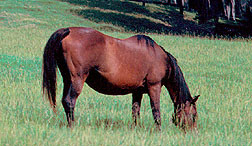Science Update
More Clues on Horse Toxin
New findings may lead to help for a disease that destroys brain cells in horses. Equine leukoencephalomalacia, or ELEM, is a rare disease caused by a toxin that frequently contaminates corn, but at concentrations of less than 1 or 2 parts per million. In 1995, ELEM killed 38 horses in Kentucky and Virginia.
The toxin in corn, fumonisin, is made by the fungi Fusarium moniliforme and F. proliferatum. Dietary concentrations in excess of 15 ppm can make a horse sick, and the damage is irreversible.
The toxin interrupts the way in which a horse's liver, kidney, and possibly other tissues make fats known as sphingolipids. It also causes sphinganine—an intermediate fat molecule—to accumulate, while depleting supplies of other necessary fats.
According to a study by ARS and University of Georgia scientists, there is another fungal compound that can temporarily reduce sphinganine accumulation in mice. Several species of fungi make this compound, known variously as ISP-I, myriocin, or thermozymocidin. If the finding is confirmed, it may lead to treatments for sick horses, as well as to ways to prevent the toxin from harming them. ARS and Emory University scientists have received a patent on a technique to detect fumonisin poisoning in an animal's tissue, blood, and urine based on changes in sphinganine. The Food and Drug Administration is considering recommendations to protect both humans and livestock from fumonisin.
Ronald T. Riley, USDA-ARS Richard B. Russell Agricultural Research Center, Athens, Georgia; phone (706) 546-3377.
Science Project Ideas for Kids
Elementary to high school students in a hurry can visit a new web site for a list of 140 publications full of ideas for science projects—most related to the agricultural sciences. The site, "Projects and Experiments for Young Scientists," was set up by the Technology Transfer Information Center of ARS' National Agricultural Library. It's the latest effort by ARS to interest young people in science. The publications list hundreds of project ideas on subjects ranging from Christmas tree farming to Samoan fruits and vegetables. Many of the publications should be available at local public and school libraries. The site's address is http://www.nal.usda.gov/ttic/misc/juvag.htm.
Also for kids is a web site produced by ARS' Information Staff, "Science for Kids." It has stories about ARS research geared to students ages 8 to 13 and can be found at http://www.ars.usda.gov/is/kids.
Kate Hayes, USDA-ARS National Agricultural Library, Beltsville, Maryland; phone (301) 504-6875.
News on Cancer Link to Excess Beta Carotene Supplements
Why did high doses of beta carotene supplements apparently increase lung cancer rates in smokers in two large intervention trials a few years ago? A study of ferrets may have found an answer. These animals absorb and metabolize beta carotene much as humans do. In the study, excess beta carotene stored in the ferrets' lungs became oxidized into byproducts that decreased a tumor suppressor and increased a tumor promoter. ARS and the National Institutes of Health (NIH) funded the research.
The findings emphasize the advantage of getting important nutrients through foods, rather than supplements.
Several studies have suggested that people who eat abundant fruits and vegetables rich in beta carotene and other carotenoids have a lower incidence of cancer, particularly lung cancer. Body cells convert some beta carotene into a vitamin A-like compound, retinoic acid, that may dampen cell division. It is being used to treat skin cancer and leukemia. But the new study suggests that an excess of beta carotene—if exposed to high oxygen levels in lung cells and oxidizing effects of cigarette smoke—could thwart its protective potential.
In tests, some ferrets received beta carotene in amounts proportional to the 30 milligrams per day given in large human trials by NIH and researchers in Finland. For 6 months, one group of ferrets received both the supplements and exposure to cigarette smoke that was equivalent to a person smoking 1-1/2 packs a day. Two other groups got just the supplements or the smoke; a control group got neither. Gene products that promote cell division were highest in the group that got both treatments—three to four times higher than in the control group.
Robert Russell and Xiang-Dong Wang, Jean Mayer USDA Human Nutrition Research Center on Aging at Tufts, Boston, Massachusetts; phone Russell at (617) 556-3335, Wang at (617) 556-3130.
"Science Update" was published in the May 1999 issue of Agricultural Research magazine.







